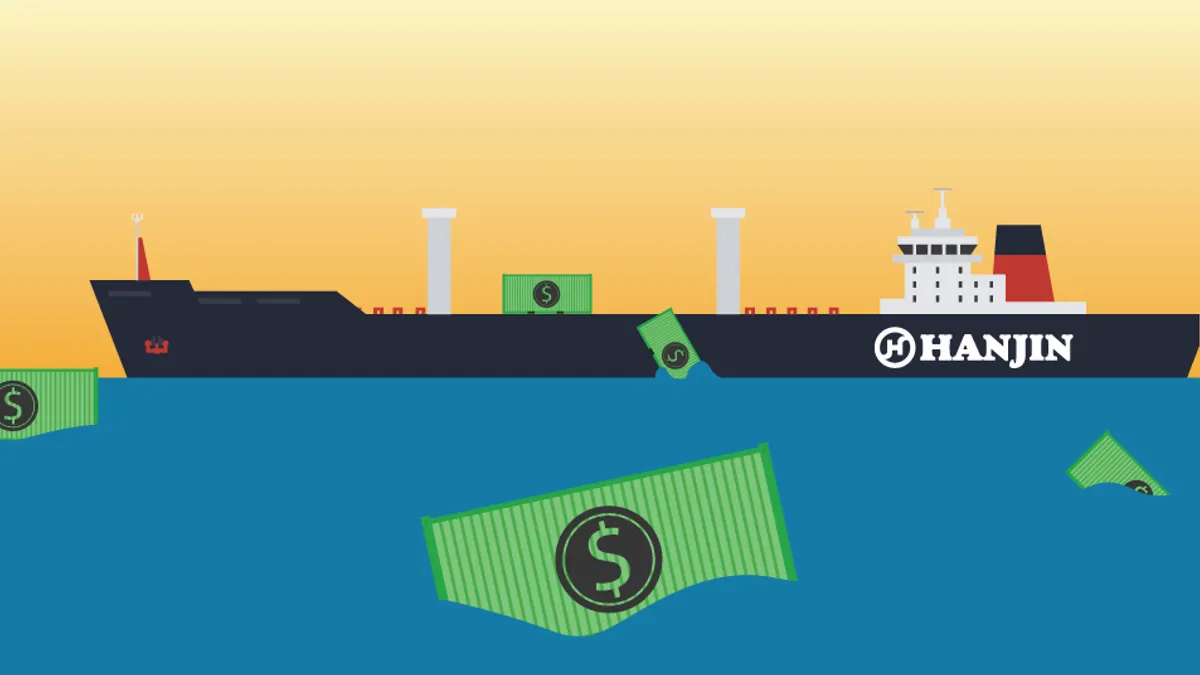Editor's Note: This article is part of a series on the supply chain effects of changes to the ocean freight industry. All stories in this series can be found here.
As the shipping industry continues to consolidate, ocean rates climb based on a myriad of factors. Experts weigh in on what impacts ocean rates and how they’ve changed over the past few years, but even they don’t have all the answers as the shipping industry remains in flux.
Ocean rates are calculated based on cargo volume against available space. When shipping lines consolidate or go out of business, more cargo will be carried by fewer ships, and the reduction in the supply of available cargo space drives up the rates. To illustrate, based on data compiled by Xeneta, ocean rates between Asia and North America rose 40% after Hanjin Shipping declared bankruptcy and exited the market in February.
But understanding where ocean rates are headed is complicated. Many variables affect the calculation of an ocean freight rate, plus, historically rates are privately negotiated, which results in imperfect market pricing and a clouded view of the future. This is why analyzing ocean rates and the shipping industry can be so difficult.
The battle for transparency
In a February debate, Freightos CEO Zvi Schreiber and CargoSphere CEO Neil Barni discussed the evolving shipping industry and explained where they think the shipping industry is headed.
Schreiber believes it’s just a matter of time before all ocean freight rates are publicly viewable on the internet — transparency is the zeitgeist, and shippers and carriers aren’t exempt from it.
“Everything is becoming transparent … our industry is not immune,” Schreiber said. “Do you remember when real estate prices were a well-kept secret? Well along came Zillow and now everyone knows.”
Schreiber expects a similar platform to emerge for ocean freight prices — not only is it inevitable, but it’s also desirable. According to Schreiber, more transparency in rate negotiation means fairer rates and more equilibrium in the market.
In the internet age, there are no suckers anymore.

Zvi Schreiber
Freightos CEO
“Of course service providers do like to discriminate on pricing, but in the internet age, there are no suckers anymore,” he said. “Everyone has or will soon has perfect access to information. Being public and transparent allows you to sell more and sell more transparently.”
But Barni thinks the need for loyal buyer-seller relationships will keep rate negotiations private and argued that useful information does not always necessitate transparency.
“Being a good partner counts, being loyal counts,” he said to Schreiber. “Confidential pricing allows price negotiations and strong partnership building. These relationships matter. Carriers and forwarders don’t necessarily need public marketplaces to do this.”
As an online start-up online marketplace, Freightos, compares prices on its platform in real-time and helps shippers find the forwarders and carriers they need. Freightos is already comparing hundreds of rates and garnering dozens of clients, so if carriers don’t start becoming more transparent, they could start losing business.
How are ocean freight rates calculated?
But even if pricing information were more readily available, understanding ocean freight rates is still more complex than simply paying attention to the ebb and flow of the market. While cargo volume and available capacity are part of these quotations, freight quotations are long lists of variables comprised of three categories of fees: pre-carriage fees, carriage fees, and on-carriage fees. Many of these fees can be impacted by external factors, which is one of the reasons why shipping supply chains are so difficult to navigate.
Pre-carriage fees, according to Xeneta, include the chassis utilization surcharge, a fuel surcharge, packing surcharges, customs clearances, wharfages, and documentation charges. Any one of those pre-carriage fees can be affected by other industries, world events or regulation, especially when crossing international borders. Sometimes, fuel shortages and backlogged customs offices have as much impact on rates as do the volume of cargo and ship capacity.
Being a good partner counts, being loyal counts.

Neil Barni
CargoSphere CEO
Carriage fees — inferred during transport of cargo — include BAF and ISPS fees, low sulfur surcharge, THC and BL fees, export service and documentation fees, EBS, EIS, ERR, ERS and environmental destination fees; GAS, GRI and ISF fees, hazardous and piracy surcharges, and others.
On-carriage fees, which refer to the handling of the cargo once its ship docks, include unpacking charges, DDS and CYRC fees, demurrage and detention charges among others.
What is going to happen to ocean rates in 2017 and beyond?
Because of shipping industry consolidation, ocean rates were expected to rise in 2017, and according to Xeneta, rates more than doubled. In June 2016, rates were at $616 for a 40-foot container vessel travelling between China and northern Europe; a year later, the rate was at $1,470.
“This indicates to us that the market is continuing to pick up, and that long‑term contracts are expected to continue in increase,” Xeneta CEO Patrik Berglund said in aJuly 6 webinar.
Xeneta believes the rates reflect an upward trend in the market, but as sales increase, some industry leaders disagree whether ocean rate negotiation will remain private as the shipping industry slowly adjusts to digitalization.
Because the shipping industry has been slow to adjust, it’s hard to say whether it — or an opportunistic 3rd party like Freightos — will copy housing market companies like Zillow and start publishing rates publicly on the internet for anyone to observe. Regardless, the industry’s recent upheavals continue to keep the rate market volatile. Shippers should expect rates to stay high for the rest of 2017, and if price negotiations remain private, the market prices will be imperfect.






















